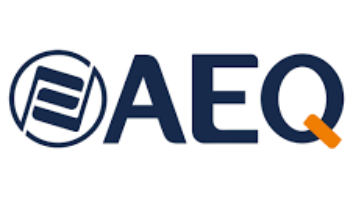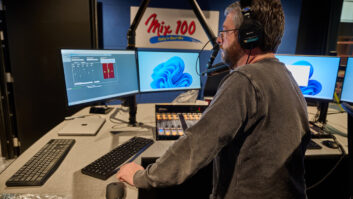The Alphabet Soup of Codecs
Apr 1, 2004 12:00 PM, By Chriss Scherer, editor
The term codec describes the function of encoding and decoding audio to pass through a defined data path. In radio, this term carries a more specific meaning to include the system used to send and receive audio as well as the encoding algorithm, interface and connection schemes. The first applications of a codec in radio were hardware devices for Switched 56 and ISDN service. Despite the more general use of the term codec to mean a coding algorithm, such as Layer III, G.722 or Apt-x, in radio we continue to apply it to the entire transmission system and not just the algorithm. It’s easier to call the device a codec instead of a switched or fixed communications service interface for bidirectional, fixed-bandwidth transmission links with an audio encoder/decoder to accommodate the limitations of the transmission medium.
While the industry will continue to use the terms in their already-defined uses, for clarity here we’ll refer to a codec as the complete transmission device and the coding method as an algorithm or an encoder.
Codec usage in radio has become second nature. When they were first introduced, codecs were magical devices that were difficult for non-technical people to understand. Today there are few challenges remaining when providing a high-quality audio connection from one point to another. What was once a struggle to create the necessary connection has become routine. If a POTS line or ISDN is available, it’s easy. If an Internet connection is all that’s available, it can be done with a little more effort. Some stations are even finding success with Wi-Fi and other less-poven connection methods.
In any outside broadcast or remote setup, simplicity is the key. The operation of the current codecs is slightly more involved than placing a telephone call. Some configuration of the units is necessary, but even these steps can usually be handled by the least-technical people. Most codecs provide a way to store common settings for instant recall. Instead of manually entering various numbers and selecting types of service, the user can select a setting with an obvious name, such as City Amphitheater, and be done. Once the unit is connected, the user dials a number or enters an address, which can also be stored in a phonebook for simple recall.
In addition, many units auto negotiate, meaning that they sense the equipment on the far end and make the necessary changes in configuration settings. This eliminates the additional effort in set up.
Many functions and overall operation are now universal between codecs as well. Non-technical users have accepted the technology and have become familiar with the concept. Like other technology introductions, initial use may be awkward, but in time becomes simple to use. In many cases, causal users are able to use the technology without much difficulty.
From start to finish
When codecs were first introduced, their specific function required specific hardware. The inner workings of a hardware-based codec have software inside of them, but the software/hardware marriage is optimized for the unit’s function. The hardware approach is common in many de-vices used around the station, and it works well.
Software designs rely on a robust operating system and associated hardware. In a purely hardware package, this can be controlled. The IT side has improved to make software-based codecs practical, as we have seen in other developing technologies. To make it all work, interface hardware � a sound card and necessary modems, terminal adapters or NICs � is required.
Given the proliferation of PCs everywhere, applying the function to a software design was inevitable, and there are several companies today that offer software-based codecs. The software approach can merge the various elements into a simple interface for seamless operation of the various components.
The software-based designs provide the same complete system as the hardware designs, but it is easier to recognize the various component parts, making similarity of the software codec and the encoding algorithm function that is at the heart of these systems easier to recognize.
Natural selection
Codecs have evolved in their use. While ISDN and POTS services are still the most popular applications, the technology is now being applied to other connection methods. Internet, intranet and other network applications are being used as the transmission paths. The latest generation of codec is built to handle this move, breaking the codec function down into its component elements of functionality.
The codec evolution is far from over. As new communications services become available, stations begin using them to simplify setups. The developments in wireless telephony are also being used to provide wireless remotes with the simplicity of a cell phone and the quality that is required by the most demanding stations.
Resource Guide
A sample of available codecs
While the Resource Guide is far from a complete list, it should provide enough basic information to help you get started.
The Telos Systems Zephyr Xstream ISDN transceiver includes MPEG AAC (Advanced Audio Coding), low-delay AAC-LD, Layer II and Layer III coding algorithms. An Ethernet port allows for streaming over IP and also networked remote control. It is available in a rack-mount version, rack-mount version with mixer (MX) or portable version with mixer (MXP). V.35/x21, Ethernet-only or ISDN-only options are also available. The mixer version adds a four-channel stereo mixer. The portable version provides the mixer as well and also adds a rugged, road-ready portable chassis. The mic inputs feature selectable AGC/limiter processing presets from Omnia.
Also from Telos Systems: Zephyr Xport POTS/ISDN codec
216-241-7225
www.telos-systems.com
The Comrex Matrix handles POTS, ISDN and wireless in one package. Available in a studio (rackmount) version and a portable version, it delivers 15kHz full-duplex audio on a single, standard telephone line via an integrated V.34 modem and is compatible with the Comrex Bluebox, Hotline and Vector codecs. It provides ISDN operation using ISO/MPEG Layer III or G.722 via an optional module. With the optional GSM module, up to 7kHz of audio can be transmitted via a wireless provider. The software is flash upgradeable through a multi-purpose dataport. A rechargeable NiMH battery kit is available.
Also from Comrex:The Nexus and Envoy ISDN codecs, and the Bluebox and Vector POTS codecs.
800-237-1776
www.comrex.com
The MDO AudioTX Communicator runs on Windows 98 and above and uses any standard sound card. The unit can be used with a laptop and connects to all major ISDN audio codecs. The software will automatically detect the codec on the other end and reconfigure itself. The system can communicate via IP or over private leased lines. The software supports a single BRI and communicates via MPEG 2 and MPEG 3 in mono/stereo/joint stereo modes, G.722 and G.711.
Also from MDO:AudioTX Capture ISDN call recorder, AudioTX POTS
+44 121 256 0200
www.audiotx.com
A line of streaming audio codecs with three models, all are ISO/MPEG standards Layer II and Layer III fully compliant, with two models also TCP/IP and UDP addressable over the Internet. Orban Opticodec technology meets the needs of anybody moving audio over the Internet, and of individuals working in radio and TV broadcast, and in voice, music and other audio-on-demand environments. Opticodec reduces the bandwidth required to transmit audio between the source and remote, studio or other TCP/IP, UDP or ISDN receiver location.
Also from Orban:Opticodec-PC software codec
510-351-3500
www.orban.com
The Maycom Isys Pro is a PC-based, Windows ISDN codec. It runs in combination with an ISDN board and Maycom’s M20 audio board. It can store all live communications instantly onto the PC hard drive. The software can also automatically accept and record audio from reporters in the field or remote studios. It supports MPEG2 Layer II, G.711 and G.722 protocols. Connections are made by selecting the phone number desired from the phone book window and clicking the dial button. During a connection, the main window shows the connection status of the two B-channels and a count-up timer.
+31 481 453466
www.maycom.nl
The AEQ Swing is a portable audio codec with built-in ISDN terminal adapter, double port interface compatible with ETSI (Euro-ISDN) and ANSI (National-1) communication standards for 64 and 128kb/s. It features a digital telephone hybrid for analog lines, incorporating features such as frequency extender and echo cancellation, and connection through cell phone as a backup or additional coordination circuit for the ISDN connection. The portable mixer has three mic inputs plus an auxiliary in/out, with a VU meter to monitor input/output and compressor/limiter on the output.
Also from AEQ:Eagle ISDN codec
954-581-7999
www.aeqbroadcast.com
The Harris Intraplex Intralink ISDN monitor can control as many as six basic-rate ISDN lines in a 3RU shelf. It handles any combination of program audio, voice and data using standard Intraplex channel modules. Five shelves can be linked for a maximum capacity of 30 BRI, and it is is compatible with most industry codecs. The unit delivers MPEG program audio up to 128kb/s and delivers LAN data at 128kb/s. It is Telex and Clearcom voice and data compatible for remote intercom use and is field-configurable via a Windows-based user interface.
Also from Harris Intraplex:Intralink IP
877-INTRAPLEX
www.intraplex.com
The Systembase C450xr includes the capability to work with 13 international ISDN standards on-board for world-wide use. It can operate with a path up to 384kb/s. The 20-bit VU meters display audio levels. Features include an external trigger dial, dial on audio/hang up on silence mode, 26 configuration memories, a 1RU enclosure and an auto-ranging power supply. The codec also provides an X.21 connection port.
Also from Systembase:C310xr and C400xr ISDN codecs
+44 1747 861123
www.systembase.com
The Musicam USA Netstar allows bidirectional real-time audio, contact closures and ancillary data in a 2RU chassis. Stereo analog and AES/EBU inputs and outputs are standard. Netstar can send and receive bi-directional audio via IP, ISDN and all types of dedicated data circuits. This product contains coding algorithms including G.711, G.722, MPEG 1 and 2 Layer II, and MPEG 1 and 2 Layer III for compatibility with older codecs. In addition, it provides MPEG 2 AAC and MPEG 4 AAC low-delay encoding for high audio performance at lower bit-rates.
Also from Musicam USA:Roadstar portable ISDN/IP, Superlink, CDQ Prima Series ISDN, Prima LT and LT Plus ISDN codec, Road Runner POTS, Liberty POTS.
732-739-5600
www.musicamusa.com
The Mayah Merk II is a codec and built-in mixer with four switchable mic/line inputs and four headphone outputs, switchable phantom power 48V with LED indication, one or optionally four ISDN BRI connections, 10/100Mb/s Ethernet for audio-via-IP and wireless-LAN and extended mixing capabilitites. Available coding algorithms include G.711, G.722, L2, L3, MPEG 2/4 AAC, Apt-x, Enhanced Apt-x, CT-aacPlus, MP3Pro and linear audio together with networking via ISDN, X.21, E1 and Ethernet. The unit also offers low delay-algorithms.
Also from Mayah:Sendit software POTS/ISDN codec, Centauri ISDN/IP codec
+49 0 811-55-17-0
www.mayah.com
The Tieline Technology Commander POTS codec with optional ISDN upgrade and wireless interface delivers 15kHz bi-directional low delay audio over a standard telephone link. It features two mic/line switchable balanced audio inputs, one balanced output, two CMOS relay contact closures, a switchable 10-LED VU meter and full remote controllability. The Commander can be upgraded with a plug-and-play ISDN interface card and software kit capable of delivering 15kHz audio over a single 56 or 64kb/s B channel or 7kHz speech using the G.722 algorithm. A range of datacasting upgrade options is available. Commander is available in a 2RU rack unit and a compact field unit.
Also from Tieline Technology:Imix POTS/ISDN codec with mixer, Patriot POTS codec
888-211-6989
www.tieline.com
The Audio Processing Technology Worldnet Tokyo is a multi-algorithm, full-duplex, stereo audio ISDN codec offering all popular coding algorithms, including standard 16-bit Apt-x, Enhanced 16-, 20- and 24-bit Apt-x, MPEG 1 and 2 Layer II/Layer III (MP3), G.711, G.722 and MPEG 2 AAC. This allows the unit to connect to all established ISDN audio codecs. The unit will accept as many as four BRI ISDN lines. Separate send and receive algorithms can be used.
Also from APT:Worldnet Rio, Worldnet Rio Lite, Worldnet Milano, Worldnet Chicago, Worldnet Skylink, Worldnet Ohio, Worldnet Duo and Worldnet Porto.
323-463-2963
www.aptx.com
The ATA Scoop E-Z is a portable audio codec. It can communicate via POTS and ISDN, Inmarsat terminals and wireless/GSM connections. Broadcasts benefit from the maximum bandwidth available. Audio features include a two-channel audio mixer, selectable compressor and limiter, phantom and T-power, VU or peak LED metering and two headphone outputs with adjustable output. The unit can automatically answer and recognize incoming call types for ISDN and POTS. It measures 9″ � 6″ � 3″ and weighs less than 4lbs.
Also from ATA Audio:Scoop Studio ISDN/POTS codec, Hifi Scoop 3 ISDN codec.
973-288-8009
www.aetausa.com
The golden age of wireless � remotes, that is
By Tom Hartnett
Ten years ago, the word cell phone was defined by a clear set of technical protocols. The word meant an analog modulated two-way radio operating in a band around 900MHz. A cell phone can still be defined this way, although it’s getting harder to find them.
Personal communication service
PCS, or digital cellular (2G), was a response to the increased demand for portable phones. Contrary to what digital cellular companies would have you believe, the advantage in PCS is really theirs, as it allows them to crowd many more phone calls into their frequency allotments. Most of us use 2G phones today. Around 1994, a new band was opened at nearly double the frequency (1,900MHz). Three distinct digital modulation techniques are defined for this band. TDMA was adopted by a few North American operators due to its easy conversion from analog cellular. GSM, although similar technic-ally, was an international standard that defined a larger feature set and became popular worldwide. CDMA, based on an entirely different (and arguably more advanced) modulation scheme was chosen by some operators. So the band became a mix of different, incompatible digital protocols. Table 1 shows the national players and their respective digital technologies. Note that with the exception of Nextel, TDMA is in its sunset years.
Real-time challenges
To provide anything better than cell-phone quality audio over these networks, broadcasters must use a data service rather than the voice service provided by the network. Because these were designed for e-mail and Web-serving applications, this is especially challenging. GSM and CDMA providers each offer packet-based, high-speed Internet connections (GPRS and 1X respectively) but due to factors such as latency, asymmetry and dynamic allocation, they haven’t proven suitable for real-time transfer. They can be useful in non-real time audio file transfer. So broadcasters must rely on connection-oriented circuit-switched data (CSD) services.
A wireless CSD network can be considered a chain of three distinct links. The first is the actual radio link between the mobile phone or codec with an integrated phone and the local cell tower. The second link exists inside the network cloud and comprises the trunks that transfer data between the cell tower and a modem pool owned by the wireless provider and residing somewhere in the network. The final link is an analog telephone connection between this modem pool and the modem at the studio. For broadcasters purposes, this would be contained within a studio codec. Obviously, data must move smoothly through each of these links to support real-time audio applications.
CDMA has a problem here. Comrex’s testing shows CDMA CSD connections to be packet-based within the network cloud, providing many data stalls and bursts along the chain. This means that unless we want to add many seconds of delay in smoothing buffers, CDMA isn’t a candidate for real-time. This leaves GSM.
GSM has its own challenges. The available data rate on GSM is low (9.6kb/s) and requires powerful audio algorithms to provide wideband audio. As an example, the Comrex GSM algorithm reduces data by a factor of 30:1 to achieve this. But GSM does indeed provide a steady stream of data from point A to B, so it’s the best choice for remote broadcasts.
Can you hear me now?
As anyone with a mobile phone knows, cellular service is prone to fades and dropouts, so it’s important to have reasonable expectations in performance. Our experience so far with GSM has been surprisingly good, with many broadcasts able to maintain stable operation for several hours. Comrex has even experimented with units in moving cars, boats and trains with reasonable results (although we can’t recommend you move your morning show to your news van). The main issue we see is interference with other mobile phones, so we recommend avoiding traffic jams and other areas with high cell-phone usage.
What’s on the horizon for Verizon and the others?
The deployment of third-generation wireless service (3G) has been predicted for many years. The technology promises an incredible amount of digital throughput, as well as infrastructure to support multi-media services (like real time audio). Deployment has slowed due to lack of a killer app and upgrade costs, but tests are underway in a few cities. While this network certainly holds hope for remote broadcasts, what is standardized and what is deployed are often different things. For example, in several countries where 3G is available, the only point-to-point high speed data offerings are the videophone service. Perhaps concerned about network capacity, carriers have chosen not to allow generic access to the high-speed data channel yet. Because broadcast applications can’t dictate which offerings a wireless company will provide (and our killer apps often differ from the general public), GSM networks remain the best choice for making cell phones sound good. But we continue to keep an eye on new technology deployment in the hopes of making wireless remotes sound even better.
Hartnett is technical director of Comrex.











